This was our first stop in Malaysia. And we came here after Singapore, which we loved more than we expected to. We said we would try not to compare the two cities, but we totally compared them and I think that made KL hard for us to settle into. During our first few days there we called the city “Kuala Lumpur” and the locals kept correcting us with “KL,” so we will use that term in this post! We stayed in KL for 8 nights.
City costs
To get a general idea for what things cost in KL, we compared the cost of living between KL and our previous home town of Seattle. Below is that comparison from numbeo.com. KL is a great example of why we decided to spend our first few months as full-time nomads in Southeast Asia. KL should be a huge Money Crush location for us!

What we spent
At the end of our trip to KL Alison played her Money Crush game and found that we had stayed there for 8 nights for $44.01 per person per day. That’s not bad but it’s not great either, especially for SE Asia. We didn’t have to dig deeper into the numbers to realize we definitely could have done better and spent less in this location.
The graphic below shows what we spent in KL in US Dollars. This does not include costs for our fixed expenses, such as annual medical insurance. It also does not include travel costs for getting in and out of KL. To reach KL we took a 5 hour express coach bus from Singapore for $39 per person, with lunch included.

Housing
Our housing options as full-time travelers range from a hotel booked with points or dollars, an Airbnb, or a house sit. For our stay in KL I picked a hotel option that was on the higher end for our budget in this region at around $44 per night after taxes. Even with a free hotel breakfast every day, I think I have to call that overspending. Oops.
But I did manage to double dip on points. I booked the Hilton Garden Inn Kuala Lumpur Jalan Tuanku Abdul Rahman South (that is a crazy long hotel name!) on hotels.com with their rewards value. And then we checked in and I asked the Hilton staff person we met during check-in to credit my Hilton Honors account with points for those 8 nights as well. She reminded me that my stay should not be eligible for Honors points since it was booked through hotels.com, and then she gave me the bonus points for those 8 nights anyway, along with a room upgrade. Thank you!
We loved the hotel, the super friendly and helpful staff, and the great views from our room. What we loved most about this hotel was the rooftop bar area with even more awesome views and a great happy hour!
Food
Free breakfast, but…
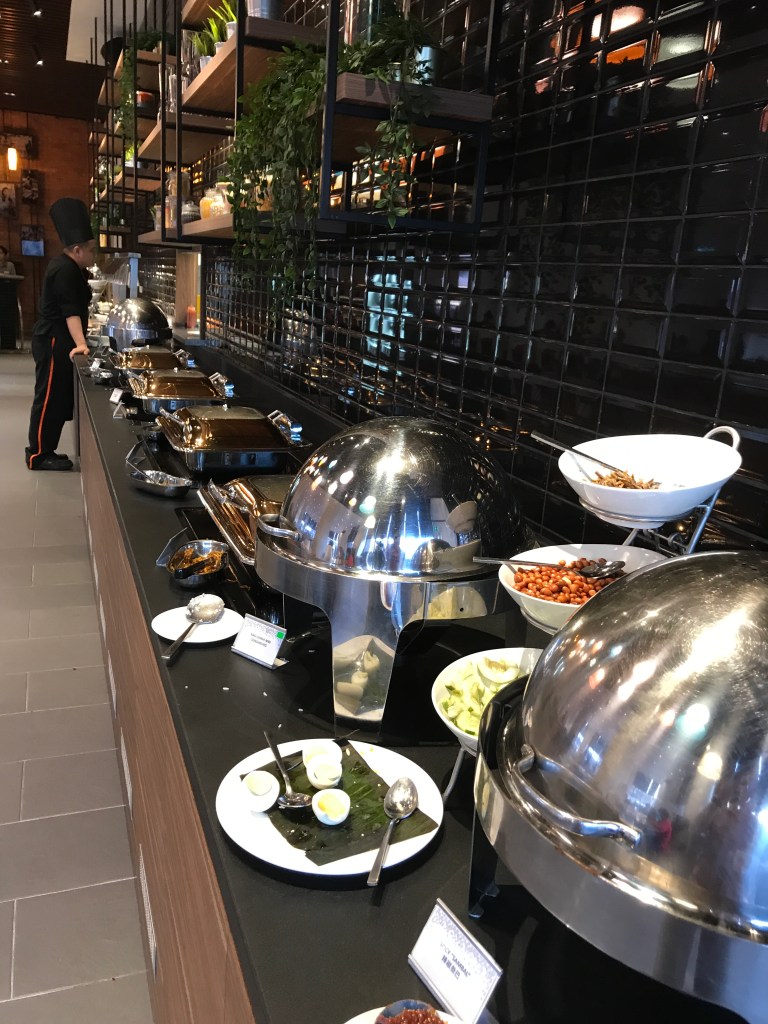
To be polite… we appreciated having free breakfast at the hotel every morning. The food was mostly Malay, which makes perfect sense. We were in Malaysia after all!!! They had hard boiled eggs and rice every day, as side ingredients for more interesting dishes. The plate of hard boiled eggs usually had about 6 eggs on it, right next to a bowls of other side ingredients including those tiny dried fish (anchovies?) we saw all over SE Asia! To be less polite and more frank, they had a wide variety of yummy Malay dishes we didn’t think were very yummy. They also had a serious shortage of fresh fruit at the breakfast buffet. There were lots of times we only had coffee and tea and hard boiled eggs, and ended up walking away after breakfast a bit unsatisfied looking for fruit and snacks.
Jalan Tunku Abdul Rahman — neighborhood street food
We walked around the area we were staying in with a goal to find street food for lunch and dinner, but we weren’t seeing a lot of street food that called our names. There were the usual skewers of meat and fresh coconuts at the hawker stalls, as well as yummy fried bananas. But most of the time we just kept walking or hopped in Grab cars to other areas. And we ended up at the Sunway Putra Mall food court area for lunch a lot, and then shopped for fruit and veggie snacks at the grocery store there in the mall as well. For dinner we cheated and ate at the hotel up on the fabulous rooftop deck a lot. So I guess we failed on the street food goal.
Jalan Alor Night Market — awesome street food
This is the one night market we really loved in KL. We walked back and forth through all of their hawker stalls and found a ton of fun dinner plates at this night market. It was a longer Grab ride from our hotel unfortunately, but I’d say this is a must visit for us in KL. If we return I want to stay in walking distance to this night market. We were still pretty new to night markets when we first visited this one, and this is the only one in KL that we really did right. It has a wild and busy vibe, and a huge variety of types of food. We loved the feel and flavors of this street food scene and had no trouble stuffing our faces with all sorts of awesome plates.
Fun
1. Batu Caves
Seeing the Batu Caves was the most important stop for us on our trip to KL. This amazing pilgrimage site for Hindus worldwide was just 7 miles from our hotel. We were really excited to walk through the limestone caves, admire the temples and statues, and just enjoy the overall experience of this important Hindu site. The annual Thaipusam Tamil Hindu festival devoted to Murugan was first celebrated at the Batu Caves in 1892, and we visited exactly one week before the festival date.
The draw for a lot of tourists is the 272 rainbow colored stairs. We loved the stairs (I think all LGBT+ people love rainbow colors!), and here they are fabulous because the rainbow colors honor the seven chakras in Hindu philosophy, from the first chakra in red to the seventh chakra in purple. The rainbow stairs are certainly fun to look at, but there are cultural sensitivities with this new paint job from August 2018, since it was done without the required authorizations for renovations at a heritage site.
Besides that, the intense gold and height of the 140 foot tall statue of Lord Murugan is even more thrilling. This is the tallest Lord Murugan statue in the world! The vel (spear) shaped entrance of the main temple cave is also amazing to look at. It resembles Lord Murugan’s spear and is the original inspiration behind creating temples at the Batu Cave. We loved standing at ground level, looking past the giant statue to the cave entrance.
We spent most of our time inside the main temple cave, and truly this is the most amazing natural cathedral we have ever visited! The temples inside are incredibly vibrant, with huge vaulted ceilings in some places and views of the sky in other places. It’s unlike anything else we have seen.
2. Perdana Botanical Garden
This is KL’s oldest recreational park. The colonial-era park was established in 1888, measures 226 acres, and is right in the middle of the city. We spent a day walking through the gardens and loved getting out of the concrete and noise of the city to enjoy such a large green space. It was fun to see so many locals there jogging and doing Tai Chi. We even felt a hint of a breeze when we were walking around the lake!
3. Chow Kit Market
This is pretty intense! You can read online that Chow Kit is the largest wet market in Malaysia. If you aren’t sure what that means, our personal definition is that this is a place where you are going to get splashed on by all sorts of icky wet things when you walk by the seafood and meat stalls. This maze of stalls is enormous and full of things to gawk at. You certainly can walk in here and just buy a golden melon or a dragon fruit or a bunch of bananas. But this universe of food stalls is clearly more of a market for people to make larger purchases of meat, seafood, and produce so they could go home and cook full meals. We wished we could have explored it more as shoppers but since we were staying in a hotel we couldn’t do much beyond pick up fruit to snack on for the day. Our real motivation for walking through there multiple times was some free entertainment and people watching!
4. Merdeka (independence) Square
On one of our urban walks we went from our hotel to Merdeka (independence) Square. This is where the first Malayan flag was raised at midnight on August 31, 1957. The site is a very important part of Malaysian independence. The flagpole was what kept our attention. The flagpole is so big our photos can’t do it justice, but it’s said to be the tallest flagpole in the world, towering at a height of 100 meters (328 feet) and it is quite impressive. From there we went to see the National Monument.
5. National Monument (Tugu Negara)
The National Monument was completed in 1966, and it’s right next to the Malaysian Houses of Parliament. The National Monument is a fairly huge memorial park that feels like a progressive lesson in Malaysian history. This is not simple stuff that honors only one side of one battle, since Malaysia has experienced longterm struggles through 2 world wars and multiple occupations, regional struggles, as well as internal conflicts. Malay people have seen all sides of every battle, and walking through this park it’s obvious that Malaysian history is that complicated. First we visited the cenotaph, a 49 foot (15 meter) tall grey stone pillar. The cenotaph is a colonial monument built by the British in honor of their martial traditions. The cenotaph was originally built in 1921 to honor the “glorious dead” from British Malayan colonies who fought in WWI. The British later added additional plaques and dates to honor the British Malayan soldiers who fought in WWII. The cenotaph was moved from its original location to the National Monument park and then modified again to honor the British Malayan soldiers who fought in the “Malayan Emergency.”
Then we walked through the pavilion to reach the war memorial that was designed especially for this site with the intent of creating a monument that is more specific to Malay people and their martial traditions. Like the cenotaph this bronze war memorial is also 49 feet tall (15 meters). This statue honors Malay independence. It’s on a very substantial platform surrounded by a beautiful set of fountains. It specifically honors those who died “in the cause of peace and freedom” including the struggle for freedom against the Japanese occupation in WWII and the Malayan civil war (the “Malayan Emergency”). On first glance we immediately recognized the similarity to the famous WWII Iwo Jima Memorial with its 6 soldiers raising the US flag, by sculptor Felix de Weldon. That similarity is intentional, since Felix de Weldon was asked to contribute to the design of this Tugu Negara sculpture to honor a similar spirit of pride and endurance in Malay people. Both sculptures are also topped by real cloth flags. The Tugu Negara sculpture includes 7 soldiers, with 5 in victory and 2 defeated communist soldiers. Combined they honor 7 qualities: command, unity, strength, wariness, suffering, courage, and sacrifice. This is complicated and intense stuff. It was very moving for us to visit these monuments!
6. Street art
KL is a city that has a lot of cool street art, both from local artists and from internationally famous artists. We spent a few days walking different areas on the hunt for street art. We started by going to see a few of the more famous pieces, like Sampan Boy by Ernest Zacharevic, and Goldsmith by Julia Volchkova. Then we walked around a few of the neighborhoods that are popular with local artists to see what else we could find. Any city that embraces street art as part of its culture is going to be fun for us to visit since we love taking urban walks and getting a feel for the beauty and the edginess of places. The only bummer was finding that the Rage Against the Machine piece by Ernest Zacharevic had been removed. A shopkeeper across the street said something to that effect and all we found was a blank wall with just the ghost of the school bus still visible. But that sort of thing is to be expected with street art, even when it’s a masterpiece for some people!
7. National Mosque (Masjid Negara)
We were pretty excited to visit the National Mosque of Malaysia, because of its bold architecture, its enormous size with capacity for 15,000 people, and the fact that its on an attractive 13 acre site. The 240 foot tall (73 meter) minaret is fabulous, as is the 16-pointed star roof. We had no intention of going inside, we only wanted to walk around the mosque and see it from a bunch of different angles. And then along the way we met a man who was also there enjoying the same views and garden space, and we got into a conversation with him about Islam, mosques, travel, and more. He was very generous with his time and personal perspective. We had never had such an in depth personal conversation on these topics before, and as full-time travelers that is exactly what we are interested in. We really enjoyed hearing what the national mosque means to him, along with its role in tourism, how it functions as a place of worship, and as an Islamic community center in KL. We were only expecting an architectural experience and got that conversation as a bonus.
8. Sultan Abdul Samad Building
We were out walking around KL and we spotted this building because it’s across the street from Merdeka Square. What first caught our eye were the circle staircase towers, which reminded us of the Da Vinci staircase at Château de Chambord in France. On first glance we guessed it was an old colonial building and indeed it was built in 1897 to house the British colonial administration. We actually hung around there for a while because the building’s history intrigued us, plus the archways were cool and breezy and we met some fun locals and tourists there as well. It also has an impressive 135 foot tall (41 meter) clock tower with a one-ton bell that has tolled every day for over 120 years. We love that stuff!
Transportation
Walkability
KL is kind of pedestrian-friendly. It’s pretty easy to walk, but it’s really, really trafficky. When we crossed streets it was usually with a million scooters weaving around us. We walked the city in the mornings, and then by midday the traffic and the heat would get to be a bit much for us and we’d escape into a Grab car to our favorite mall for some lunch and air-conditioning.

Light rail and monorail
I’m the kind of nerd that thinks transit systems are cool, so I got excited when I saw an elevated monorail line on the street our hotel was on. But. The system was not very useful for us. If you happen to be staying super close to KL Sentral station you would probably do pretty well using the local transit system. But if you stay anywhere else in KL you will need to use multiple lines that don’t connect except at or near KL Sentral. Even at KL Sentral you don’t have the kind of connected experience you have in other cities. You can’t just walk from one line to the next in the station since some of them are a street or two away in one direction or another.
Our hotel was about a 5 or 10 minute walk from the Monorail Chow Kit station. And our best KL transit experience was figuring out how to get from the Monorail, three lines west to the light rail using the Batu Caves light rail line so we could go 7 miles north to visit the Batu Caves. So maybe it made a little sense to take the Monorail south to KL Sentral, and then walk a couple blocks to the Batu Caves line also at KL Sentral, so we could ride that 8 miles north to the Batu Caves. And maybe it also made a little sense on the return trip to take the Batu Caves line south only 7 miles and get off at the Putra stop, and then walk about 45 minutes east over and under various streets zig zagging through town to get to our hotel near the Chow Kit station. But by any reasonable standard both of those options were kind of lame.
So basically the transit system in KL is goofy and unimpressive. At least our rides were cheap, only $4.76 in total spent on tickets for both of us. And though we read online that the trains would be pretty crowded and arrive every 3 to 5 minutes, the trains we took were mostly empty and we actually waited 20 minutes for one of them.
Grab cars
We used a lot of Grab cars in KL! Grab is the Uber of Southeast Asia and since KL is a big busy city, Grab cars were everywhere and very easy to get. The rides were cheap and cars showed up within a couple of minutes every time we requested one. Since we used a couple Grab cars pretty much every single day, we ended up sending $31.59 on Grab cars in 9 days/8 nights.
Where we spent our time
Bottom Line
Money Crush Score: Good, but we could have done better
Our Money Crush score does not factor in how much we liked the city, it’s focused on whether we made good financial choices and stuck to our budget. Our average daily spending goal for 2019 is $115 per day. That’s total dollars spent for the two of us. Our actual daily spending in KL averaged out to $88.02 for the two of us, or $44.01 PPPD, which is 77% of our average daily budget. That is a good score, but it’s pretty high considering the cost of living in KL. Since this is a super low cost of living area, we should have a better Money Crush score for KL. If we had been in an Airbnb we would have shopped and cooked at home, and if we had been in a different area we would have had more street food and less restaurant food. For sure the hotel prices we paid were too high for our goals in this region.
Travel Score: We liked it, but we didn’t love it
Our overall travel score is essentially a rating for how happy we were in this city, which is 100% variable based on tons of factors. This has nothing to do with what we spent, it’s based mostly on whether we want to return for a longer stay in the future. I have to admit, we were kind of out of our happy zone in KL for some reason. Part of our issue was “city shock” because KL is such a big, loud and chaotic city.
The traffic combined with the heat in KL just didn’t jive for us, and we probably would have been much happier if we had stayed in an apartment in a better area. But we enjoyed the gardens and monuments we saw. Also, our plan was to visit the national park after KL but since the canopy walkway was closed for maintenance when we were in the area we missed that side trip. So we absolutely must return to KL so we can travel from there to Taman Negara for a few days and experience the world’s longest canopy walkway in the world’s oldest tropical forest!
LGBT+ Score: LGBT+ people need to be cautious and closeted.
Malaysia is officially a secular state, but there are some hateful beliefs within the local culture about homosexuality as well as laws, provisions, and fatwas that criminalize homosexual behavior. To be clear, homosexual activity is illegal in Malaysia and violence against LGBT+ people occurs fairly regularly in this country. Two women were convicted of “attempting to have lesbian sex in a car” and on September 3, 2018, they were each caned 6 times within the Sharia High Court in the state of Terengganu in Malaysia as punishment for homosexual acts.
Sharia laws in Malaysia make it illegal for “a man to dress or act like a woman,” which means people and especially Trans people are sometimes beaten and jailed for the clothing they wear. Since Trans people cannot change the sex on their IDs they face discrimination in any situation where ID is asked for, such as interviewing for a job and opening or accessing a bank account. According to LGBT+ activists in Malaysia, LGBT+ people live in a constant state of fear and danger in their country.
If you think issues relating to discrimination would not affect tourists keep in mind there is a provision that prohibits all acts of “public indecency” which allows for broad judgement and punishment of public behaviors by citizens as well as travelers in Malaysia. Perhaps the simplest and most important thing to remember when visiting Malaysia, is that touching in general and all forms of public displays of affection are taboo.
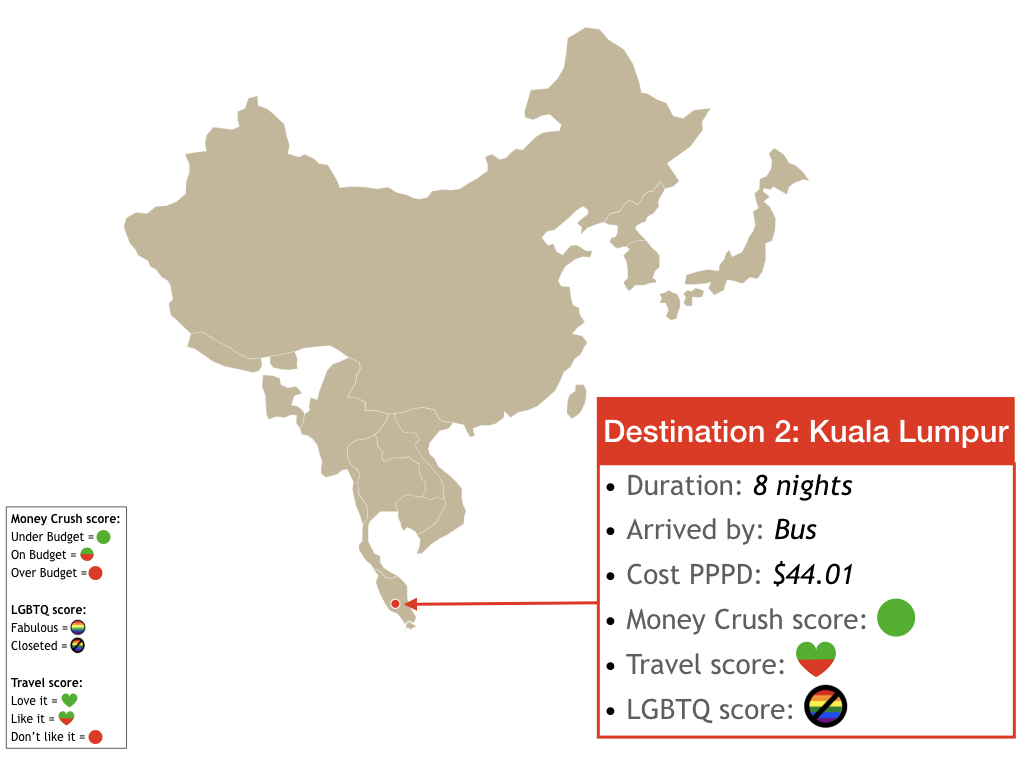
Book recommendation
I have a long list of books I want to read that relate to every place I’ve visited so far, and it’s only getting longer. I love recommendations from others by the way, so feel free to let me know if you have a favorite book I need to add to my list. For our first trip to Malaysia I picked this one:
The Gift of Rain, by Tan Twan Ang
I started this book in KL and didn’t finish it until we got to Penang Island. It was the perfect book for our stay in Malaysia. It combines issues around loyalty and family with WWII drama and ethnic/race relations. Whether you are visiting Malaysia or not I loved this book and recommend it.
Other Stuff We think is Interesting
Expat Retirement Hot Spot — But Not for LGBT+ People
Malaysia is very interested in drawing expats and their money for longer stays in their country. The government has created the “Malaysia My Second Home” program, or MM2H as they call it, to grow their expat community. Malaysia’s largest expat community is in KL, and their second largest is in George Town. With low cost of living, quality health care, and plenty of entertainment and recreation options, Malaysia is an appealing retirement destination. And KL is said to offer the 2nd highest quality of life in SE Asia (after Singapore).
Just for fun I got in touch with a couple of agents to discuss the MM2H application filing process. I thought it would be interesting to discuss the fact that I am a lesbian from America who is married to a woman, and then ask if we would have a chance of being approved in the MM2H program. The guidelines for approval are focused on financial requirements that we could easily meet. But knowing the laws and taboos in Malaysia relating to homosexuals, there are other things to consider. To clarify, Alison and I are not looking to live in Malaysia. I’m just having fun researching everything I can think of about every country we visit, including this MM2H program.
The first guy I talked to said it would be highly unlikely that MM2H would grant approval “for my spouse.” But if we just “apply individually” and hide our marriage that would be fine. The second guy I talked to basically said the same thing, if we just apply as individual cases, then there’s no issue. When pressed both of these guys were clear that we could not apply as a lesbian couple and be approved.
LGBT+ discrimination
We will not limit ourselves to traveling only to countries where everything is perfect — since there are no countries where everything is perfect. But we do want to be safe and feel comfortable when we travel. There are plenty of countries we refuse to visit because of the discrimination and lack of protections for LGBT+ people. Since there are many countries that follow discriminatory laws, practices, or traditions we try to learn as much as we can about the politics and taboos in the countries we visit. And we pay especially close attention to the laws and taboos relating to women and LGBT+ people. As a reminder, there are still states in the US that tolerate or even promote racist and homophobic discrimination.
In Malaysia, social attitudes towards LGBT+ people are certainly influenced and tainted by elements of Islam, the official religion. With Sharia laws in place, it is basically illegal to be openly gay in Malaysia. And there are many who say Malaysia is one of many countries today that is experiencing a cultural shift towards conservative thinking and is becoming increasingly conservative in their laws and practices over time. The Malaysian states that are the most conservative and strictly Islamic are Kelantan and Terengganu. The city of Kuala Lumpur is considered to be the most liberal place in Malaysia. A number of Malaysian government officials and religious leaders also work to encourage hatred and violence against LGBT+ people, such as former Prime Minister Najib Razak who declared that LGBT+ people are enemies of Islam.
And by the way, it’s too simplistic to focus on the fact that Malaysia is an Islamic State — because the sodomy law in Malaysia is actually a remnant of a colonial law so you can also thank the British Empire for that. Like so many other cultural and political issues, this one is complicated. We hope to see this government and culture continue to evolve in a positive direction so that LGBT+ people do not continue to experience such terrible discrimination in Malaysia in the future.
How big is this city?
KL is the national capital and the largest city in Malaysia. It’s home to the famous Petronas Towers, which we saw from our hotel roof bar but did not visit. KL is also home to the Parliament of Malaysia, and it’s the official residence of the Malaysian King. KL is around 94 square miles (243 square kilometers) in size. That is small! Compared to Singapore or Bangkok for example, KL is not that big, but it felt like a large sprawling city to us. The population of KL is around 1.76 million people.
Weather
Kuala Lumpur translates to something like “muddy confluence.” Enticing right? KL has a tropical rainforest climate, which means it’s very hot, sunny, and humid. And since it’s so urban, not so green, it felt really hot to us. Temperatures are fairly constant with maximum temps typically ranging between 90 and 95°F (32 and 35°C), though they can reach 104°F (40°C). Minimum temps typically only range between 74 and 76°F (23 and 24°C). While we were there the high of the day was between 90 and 94°F and at the lows overnight dipped to around 75°F, but I always add the “real feel” and since the humidity ranged between 70 and 100%, I’ll just say it was gruesomely hot and humid while we were there! Thank goodness for air conditioning.
Diversity
Malaysia has had and continues to have some tensions between ethnic groups and religions, some of which has been centered in KL. Malaysia has three major ethnic groups: Malays, Chinese, and Indians (along with a mix of other minorities). Malay/Bumiputera people make up around 69% of Malaysia’s population, but only around 46% of the population in KL. Chinese make up 23% of the population in Malaysia, and around 43% of the population in KL. Indians make up around 7% of the population in Malaysia, and climb to around 10% of the population in KL.
Islam is the official state religion of Malaysia, though Malaysia’s constitution does guarantee religious freedom. Around 61% of Malaysia’s population follow Islam, but that number drops to only around 46% of the population of KL. Around 20% of Malaysia’s population follow Buddhism, and that climbs to around 36% of the population in KL. Around 9% of Malaysia’s population follow Christianity, and in KL that number is around 6% of the population. Around 6% of Malaysia’s population follow Hinduism, and that goes up to around 9% in KL. And around 3% of the population of Malaysia follow traditional Chinese religions, but only around 1% of the population of KL.
History
Malaysia has a pretty rough political history. It’s so complicated I probably shouldn’t even try to nutshell it. But I will anyway. Today’s Malaysia only dates back to 1963. Malaysia had an obnoxious amount of colonial attention from the Portuguese, the Dutch, and then the British. The Portuguese first attacked the Melaka Sultanate and held Malacca from 1511 to 1641. Then the Dutch took that land from the Portuguese and held it from 1641 to 1825. The British first took Penang in 1786. Then the Dutch and British signed the Anglo-Dutch Treaty in 1824, whereby the Dutch gave Malacca to the British and the British gave Sumatra to the Dutch. After that the British really settled in and created the Straits Settlements (including Malacca, Penang, and Singapore), as crown colonies. The British also held additional areas of Malaysia as the Federated Malay States and the Unfederated Malay States. And as icing on the cake they established the British colony of North Borneo, the British protectorate of Brunei, and a British family known as the “White Rajas” ruled the Kingdom of Sarawak. This can all be summarized as: Ridiculous and Disgusting.
WWII had a massive impact on Malaysia and the region as well. The Japanese invaded the Malay Peninsula in December of 1941 and defeated the British Malayan Command pretty quickly. The WWII atrocities here were horrific, and from a timeline perspective the Japanese Empire conquered Malaya and occupied the territory from 1941 to 1945. When the Japanese were defeated the British immediately rebuilt their colonial holdings. The Federation of Malaya finally achieved independence from the British in 1957, on paper anyway. But the epic economic and cultural impacts from colonialism and WWII were devastating on every possible level, and not fixed by the British Parliament’s vote to allow independence for Malaya in 1957. The Anti-British National Liberation War (also called the “Malayan Emergency”and the “Communist Emergency”) was ongoing from 1948 until 1960, between the Commonwealth armed forces and the Malayan National Liberation Army (the military arm of the Malayan Communist Party). That’s a very fluffy light overview of the real deal.
It wasn’t until 1963 that “today’s Malaysia” was formed through a merging of Malaya, Singapore, and the East Malaysian states of Sabah (North Borneo) and Sarawak. But there were ongoing struggles with Indonesia and the Philippines as the region tried to rebuild after colonialism and WWII. And then the final (hopefully) messy divorce was with Singapore when they were expelled from Malaysia in 1965 because Singapore’s majority Chinese population was seen as a threat to Malay dominance. Malaysian politics and history couldn’t be more complicated!
The Monarchies
I think all monarchies are fascinating! Malaysia’s monarchy is even more so, because it’s actually 9 monarchies, with a supreme monarchy at the federal level. These monarchies are very traditional to this area but also have combined influences from ancient Malay culture, Hindu culture, Siam culture, Islamic religion, the Westminster parliamentary system, and more.
There are 9 Malay states that are constitutionally headed by traditional Malay rulers. Those 9 thrones can only be held by male Malay Muslims of royal descent. 7 of those are hereditary monarchies based on patrilineal primogeniture. The 8th throne rotates among 3 branches of a royal family using a sort of patrilineal seniority system. And the 9th throne is an elective monarchy with a ruler elected from male members of that royal family. 7 out of those 9 rulers are titled as Sultan, the 8th is called the Raja, and the 9th is known as the Yang di-Pertuan Besar.
Every 5 years (or whenever the king quits or dies) there is a Conference of Rulers where those 9 guys come together to elect one of them as the Yang di-Pertuan Agong, the federal constitutional monarch and head of state of Malaysia. The Conference of Rulers also includes the governors from the 4 other Malaysian states that function without a royal family. But it’s only the 9 royal rulers who get to vote on which of them will next take the throne of Malaysia.
While we were still in Singapore the news broke that the existing King of Malaysia had suddenly resigned, with all sorts of rumors swirling. While we were in KL that was the big story on the news every day! And we were still in Malaysia and had just settled in at our Airbnb in George Town when the news broke that the Conference of Rulers had elected Sultan Abdullah of Pahang as the new King of Malaysia. We thought it was fun to watch some of the events and ceremonies on local TV with no captions and pretty much no clue of what was happening. We were totally into it!

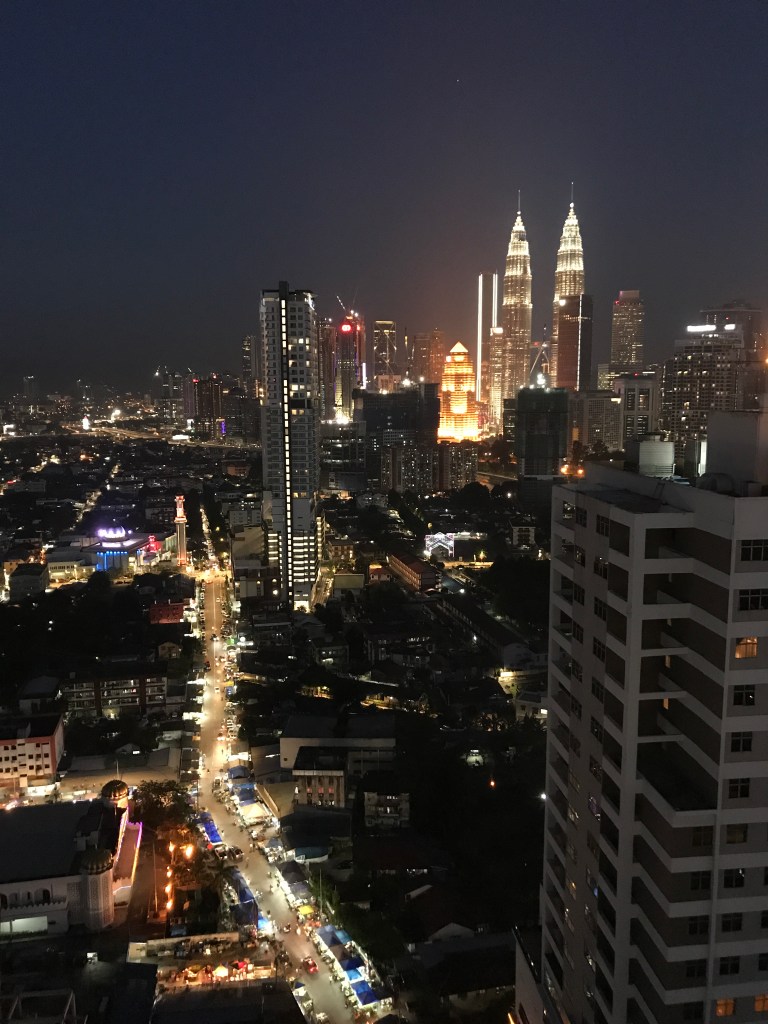

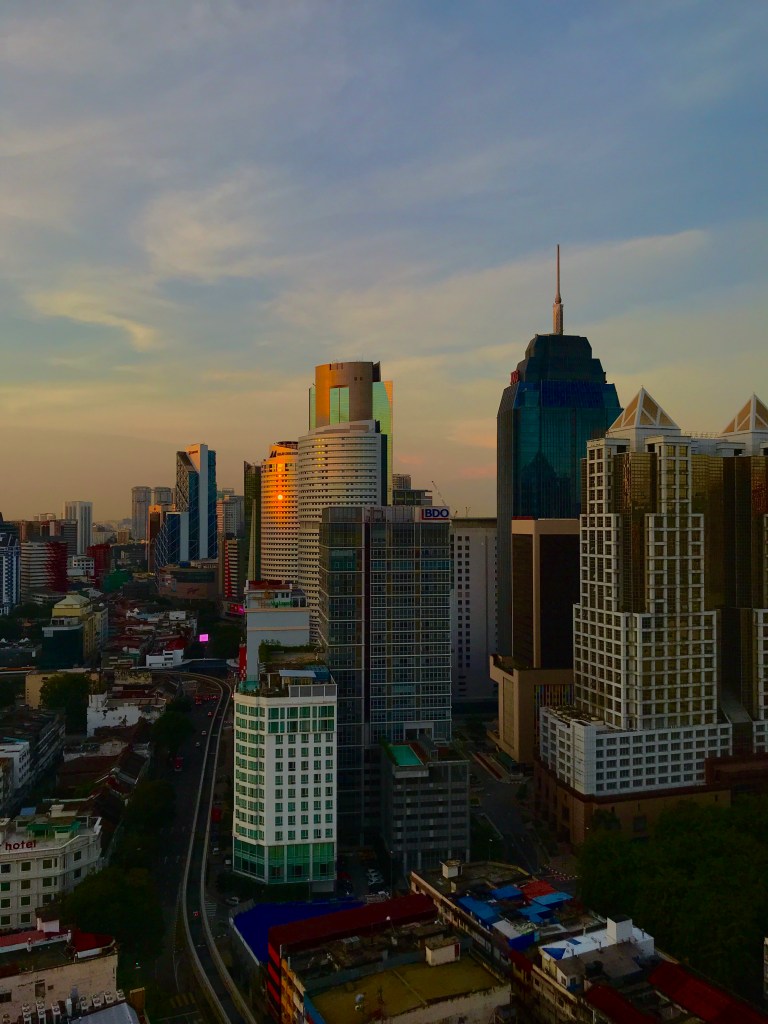












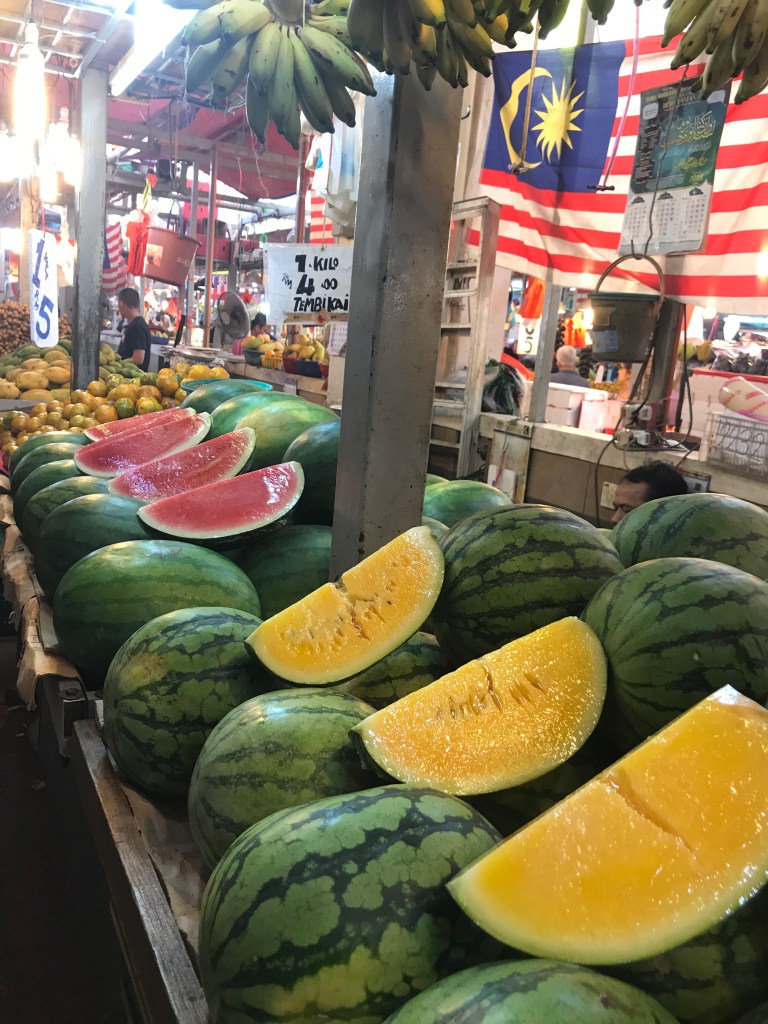


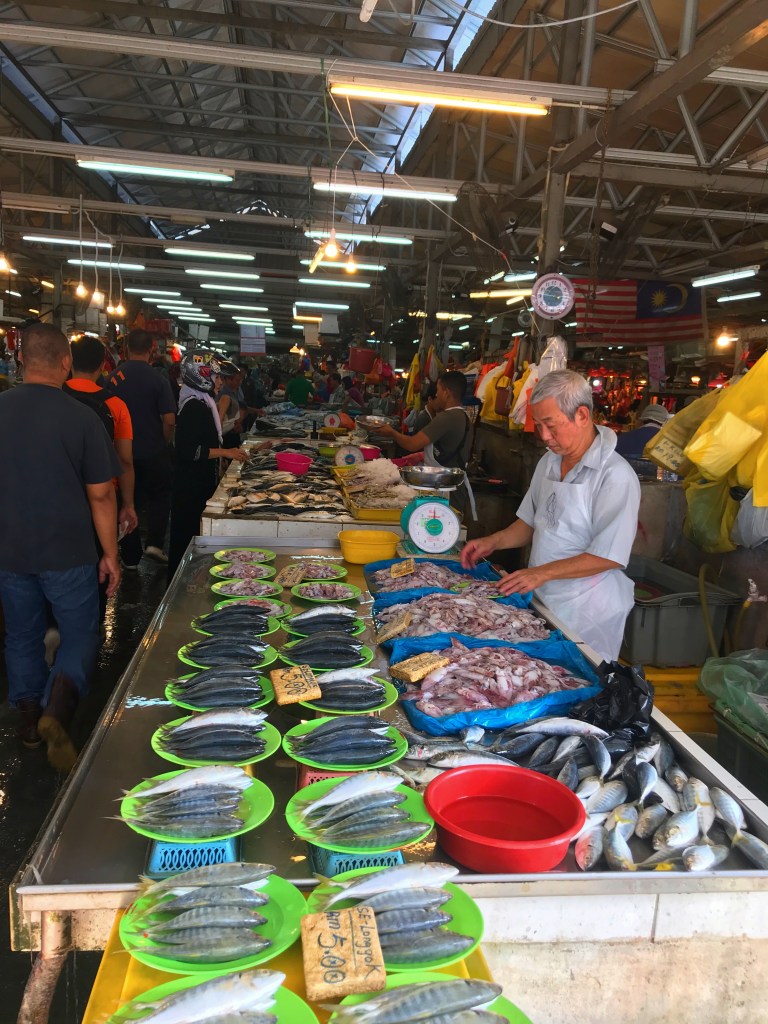


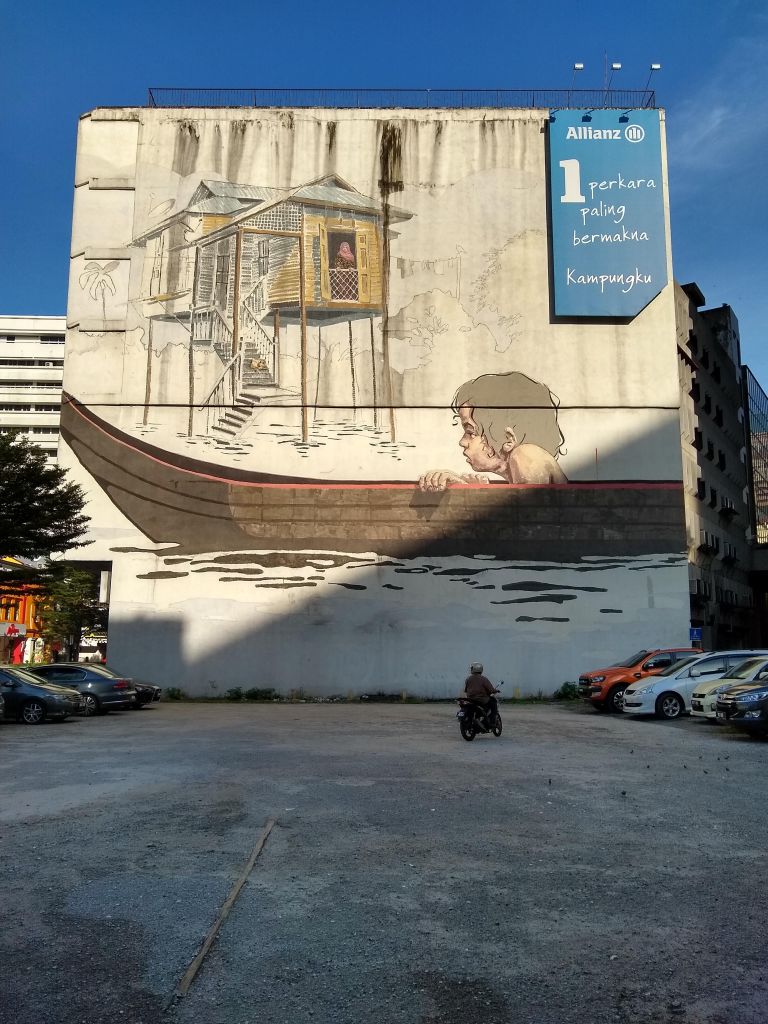
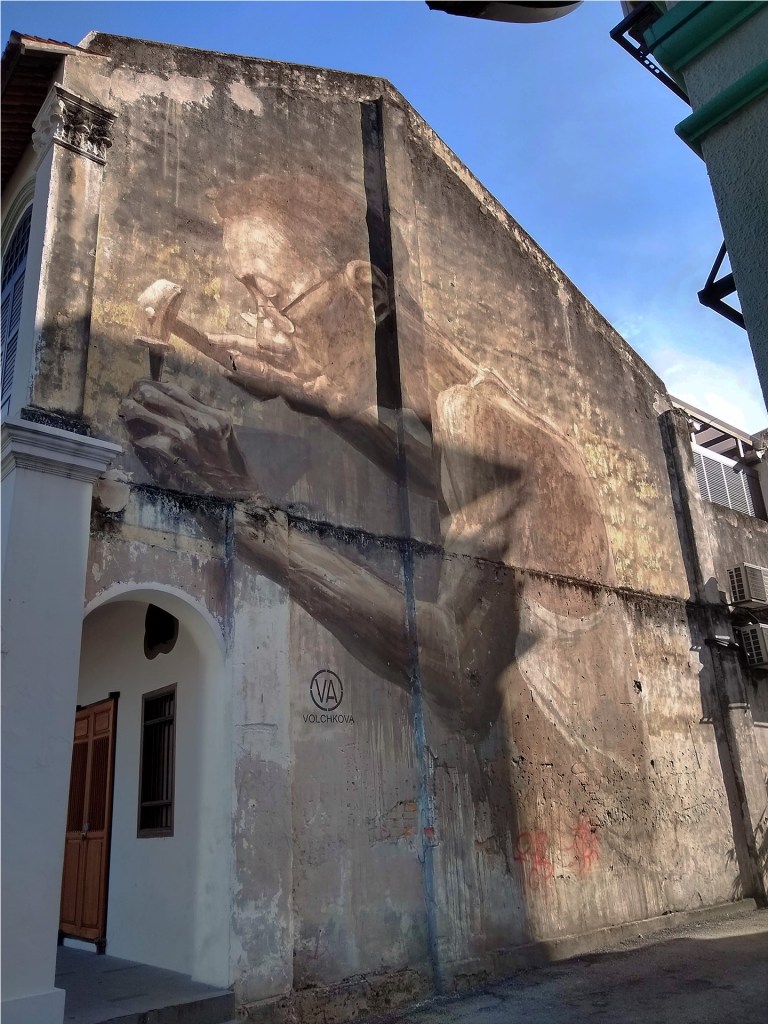
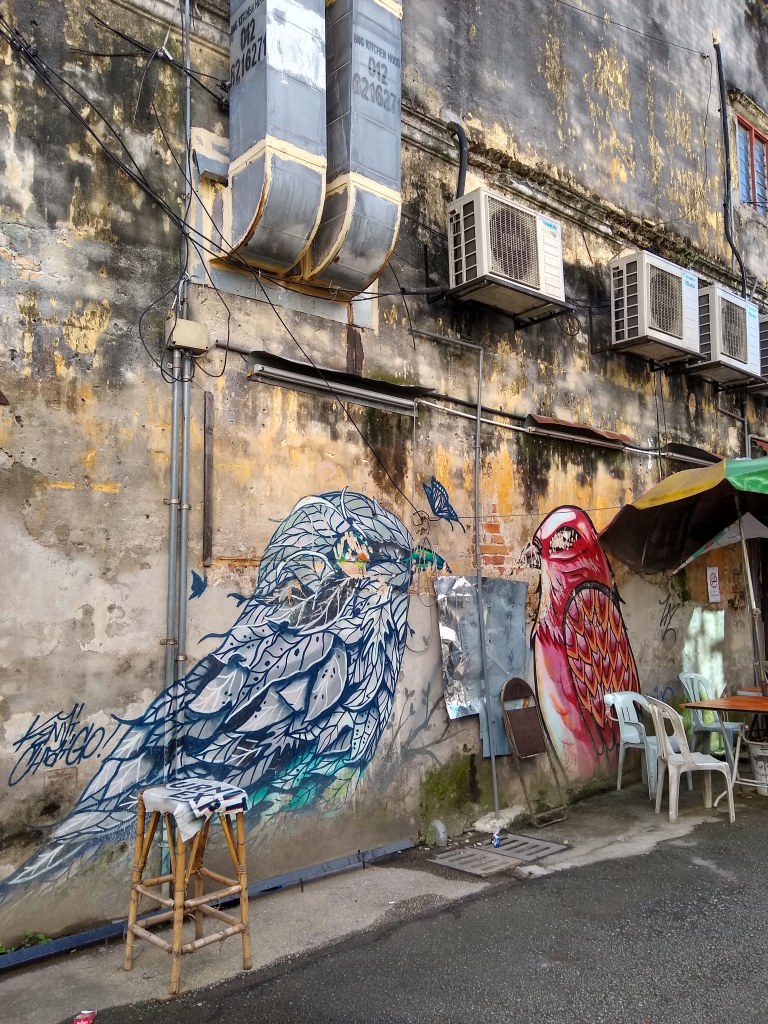



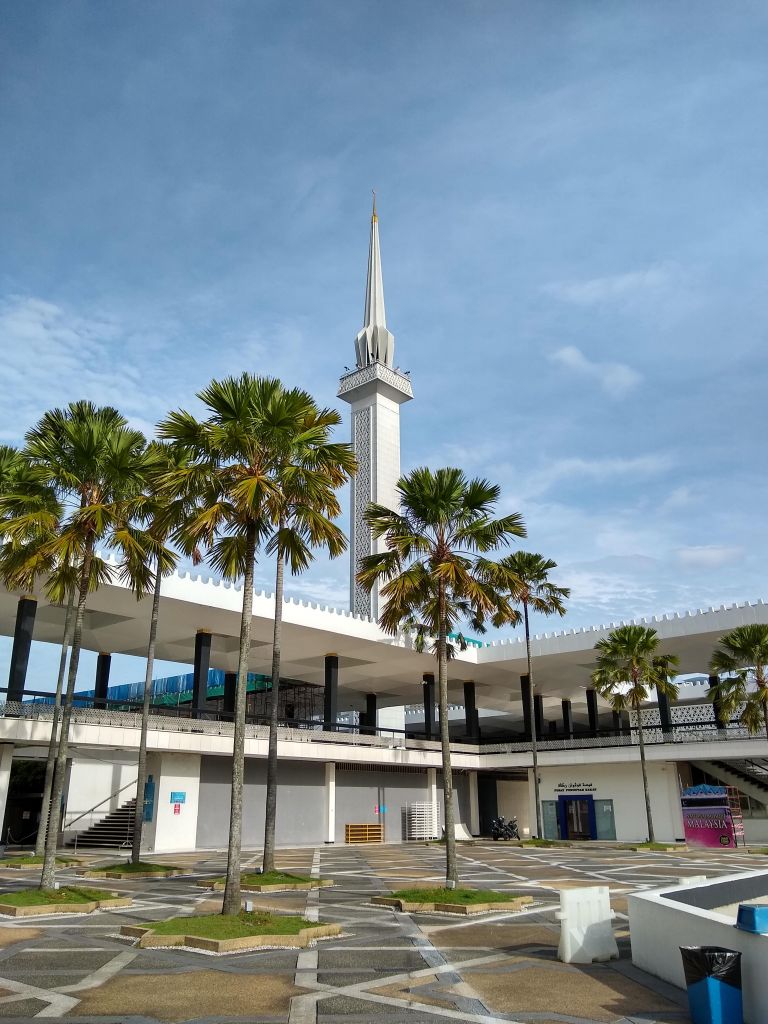



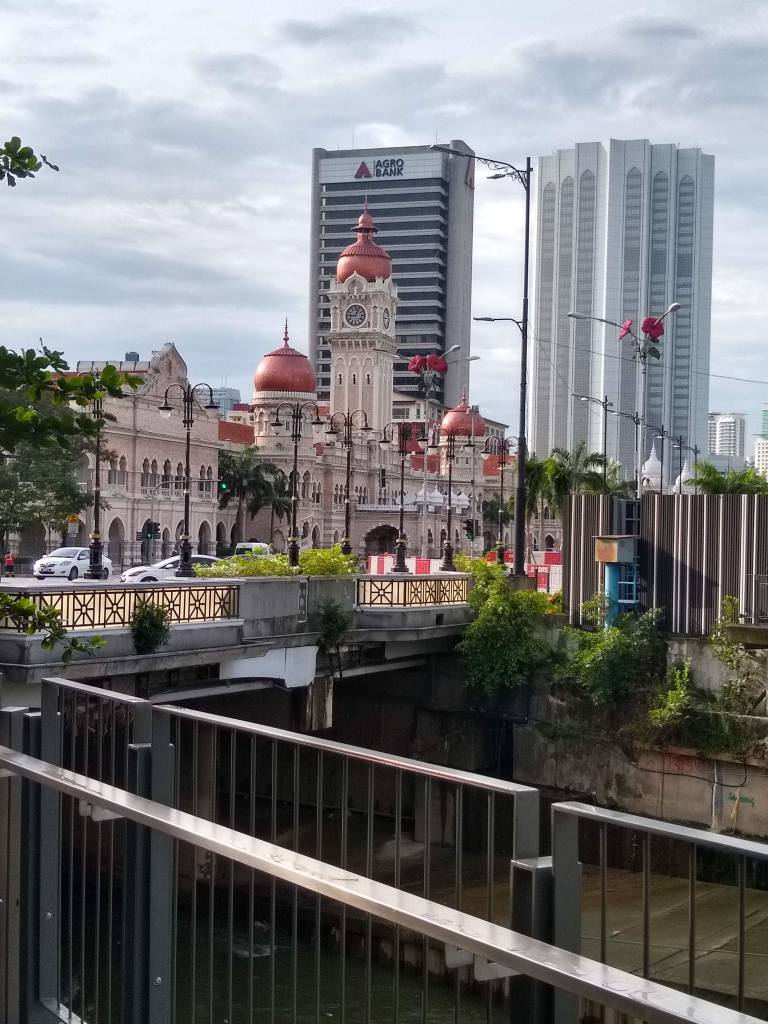
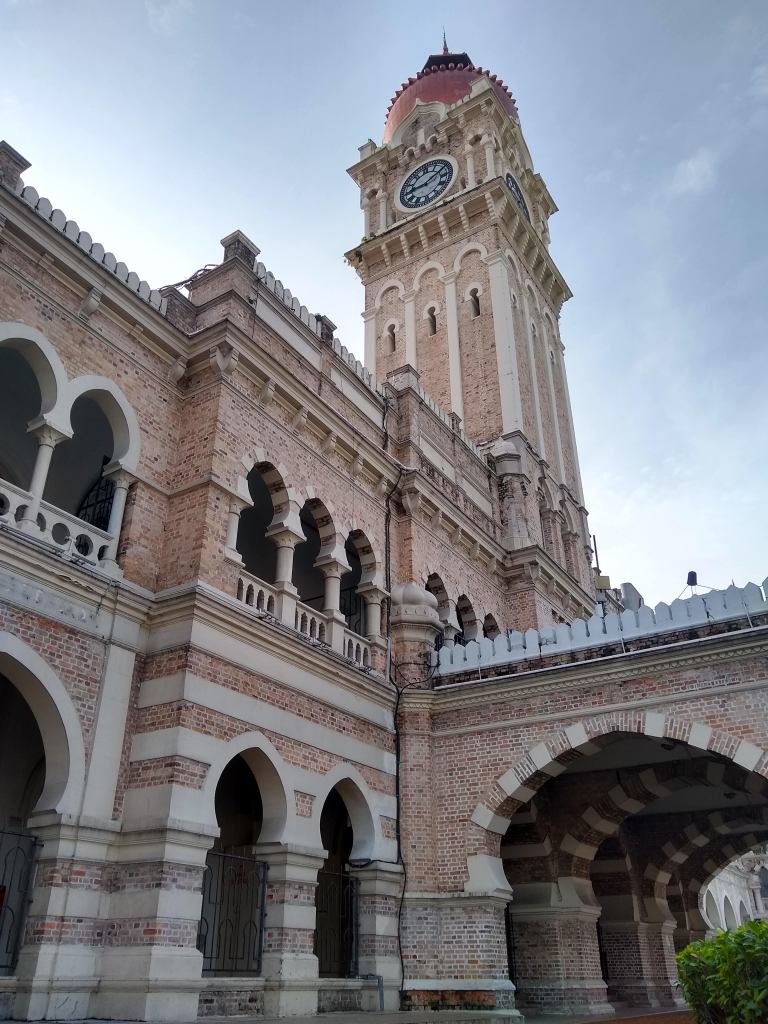

Hi Ali,
Love your level of detail, your make my “skims” look pedestrian by comparison.
Agree on the breakfast issues too, in Asia I often found myself doing a mental
drum roll as I rotated the metal dome “….and today we have…erm…what is that?”
then rotate it slowly back down again.
Always followed by the customary “toast again then…?
It sounds like KL is a bit “Bangkok-y” i.e hot, sweaty, humid and polluted. Always
feel like I need a shower every 10 minutes, spoken like a seasoned traveler obviously.
That said some of KL looks cleaner though in your pics.
Just a minor detail here too but I feel like you missed an opportunity for my favorite
analogy.. when you say it has a monorail to nowhere I would have added my now
mandatory reference – “…like Jacksonville, FL”
For reference a city that also has a strange empty monorail that takes you nowhere
you particularly need to be.
Awesome post!
Take care,
DN
LikeLike
Haha –
Gotta love that monorail to nowhere thing. Jacksonville’s story is one of the most goofy transit fails in the US! As for KL, that seriously takes bad transit “systems” to a whole new level.
But that KL breakfast was a new all time low for us. At a Hilton no less! I feel so betrayed by my favorite hotel chain. As an English dude I know you can understand this tragedy – the saddest part of that KL breakfast buffet was seeing a toaster ready to go but no decent bread to put in there! Ug. But on the bright side I think we needed to be booted out of the old pattern of relying on Hilton hotels on our travels. So much for that old safe bubble! 😉
~Ali
LikeLike
[…] Read our Kuala Lumpur City Report. […]
LikeLike
[…] Our visit to KL was full of mistakes. We were in a hotel where the free breakfast of Malay food wasn’t our favorite. We were in a neighborhood (Chow Kit) that wasn’t the best fit for us and when we went out exploring we had trouble finding food we loved, though we finally found a great night market 45 minutes from our hotel on our last day in town. KL is a very large, loud, traffic-packed city and because it’s so urban the heat and humidity were tough to cope with. The transit system doesn’t connect all the dots, so even though trains went by just across the street from our hotel there were no light rail or monorail stations close to us. We would visit again for a short stay to experience a better neighborhood, but at this point KL isn’t on our list for a longer stay. […]
LikeLike